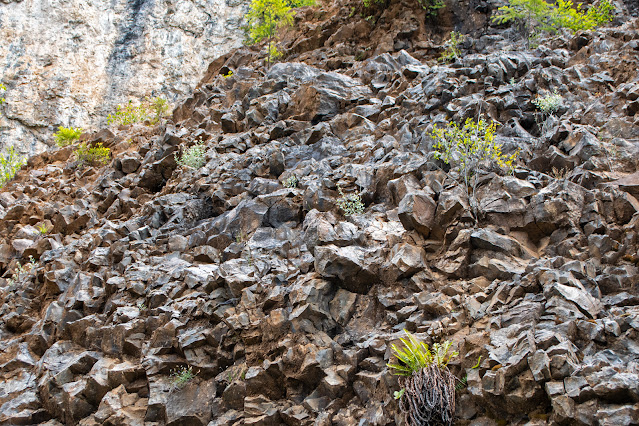I had intended to just drive on by the Buttle Lake cliffs; I had a plan and it didn't include looking at rocks this trip. But then I passed a new rock fall ...
 |
| Broken rocks beside the highway. |
The pale brown surfaces are weathered. Newly-exposed faces are dark blue-black.
 |
| The cliff above the fallen rock. |
All this is underwater rock. Or was, millions of years ago. The lumpy areas are pillow lava, lava que oozed out underwater and cooled in blobs up to a metre across. The whitish rock is limestone; the remains of tiny underwater organisms.
These pillow lavas form when basaltic lava erupts under water and is partially chilled by contact with the water. The lava thereby forms a rubbery skin through which more hot lava keeps flowing and expanding. This expansion results in ruptures of the skin and new balloon shaped buds and branches, some of which break off and roll down the slope of the sea floor to form pillows. Over time, the steady submarine eruption of lava, from cracks and fissures, built up a thick, extensive pile of these pillow lavas which totally blanketed the older rocks. They form most of the mountains west of Buttle Lake and south of Upper Campbell Lake and Elk River.(Geology of Strathcona Provincial Park)
The limestone is made up of coarse grains broken from the skeletal remains of crinoids or sea lilies which are the ancient relatives of starfish. These are now preserved as fossils and are cemented together by fine crystals of the mineral calcite. (Geology of Strathcona Provincial Park)
 |
| Broken pillows. |
 |
| Zooming in. |
 |
| And again. |
 |
| A bit further on. |
 |
| One of the rocks at the side of the road. |
The purplish colour, I am told, is probably due to manganese oxide weathering.
I picked up a bit of fossil to bring home, and a small chunk of crumbly limestone. And then went on to the planned hike.
~~~~~~~~~~~~~~~~~~~~~~~~~~
El plan era pasar los acantilados al lado de Buttle Lake y seguir adelante para buscar plantas. Pero al pasar vi una nueva caída de piedras y me tuve que detener ...
Foto #1: rocas recién caídas al lado de la carretera. Las superficies de color café han sido expuestas al clima por mucho tiempo; donde se acaba de romper la roca, son negras.
Foto #2: el acantilado allá arriba. Todo esto es roca que se formó bajo el agua hace millones de años. Las masas rotas son de lava acojinada, lava que fue extraída al fondo del oceano y se endureció formando masas de hasta un metro de diámetro. La roca blanquisca es caliza; lo que queda de antiguos organismos acuáticos.
Estas lavas acojinadas se forman cuando lava basáltica hace erupción bajo el agua y se enfría en parte por el contacto con el agua. Se forma entonces una piel elástica en la cual la lava sigue fluyendo y dilatándose. Esta expansión resulta en que la piel se rompe y se forman nuevos brotes y ramas globosos, algunos de los cuales se separan y ruedan cuesta abajo hacia el fondo del mar, donde forman cojines. Con el tiempo, esta constante erupción de lava subacuática desde grietas y fisuras construyó una capa gruesa y extendida de estas lavas acojinadas y llegó a cubrir por completo las rocas más antiguas. Forman la mayoría de las montañas al oeste del lago Buttle y al sur del lago mayor Campbell y el rio Elk. (Geología del Parque Provincial Strathcona)
La caliza está compuesta de granos gruesos quebrados de los restos esqueléticos de crinoideos o lirios marinos, los cuales son antiguos familiares de las estrellas de mar. Ahora se preservan como fósiles y se mantienen unidos con cristales finos del mineral calcita. (Geología del Parque Provincial Strathcona)
Fotos # 3 a 7: algunos "cojines" de este acantilado.
Foto #8: una roca caída al lado de la carretera. El color morado, me dicen, puede ser debido al óxido de manganeso expuesto al clima.
Recogí un pedacito de fósil para traer a casa, y un pedazo de caliza, y luego seguí mi camino, tal como había planeado.
Foto# 9: aquí solo me detuve un minutito.
Regresaré.


No comments:
Post a Comment
I'm having to moderate all comments because Blogger seems to have a problem notifying me. Sorry about that. I will review them several times daily, though, until this issue is fixed.
Also, I have word verification on, because I found out that not only do I get spam without it, but it gets passed on to anyone commenting in that thread. Not cool!